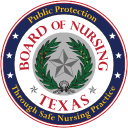Nurses in the State of Texas may interrupt their practice or change their primary area of practice for a variety of reasons. The impact that a change of practice area or lack of continuity in practice may have on the competence of the nurse is of concern to the Texas Board of Nursing, as either situation may affect the nurse's ability to provide safe and effective nursing care that complies with the Nursing Practice Act (NPA) and Board Rules. A nurse who has not practiced and is re-entering the work force after a period of four or more years may not be current in his/her knowledge base of new drugs, current therapies, and/or changes in technology. A nurse who is transitioning into a practice setting that differs greatly from the nurse's previous experience may also lack the necessary knowledge to immediately assume responsibility for patient care. In 1994, a study conducted by the Board and Lamar University identified that nurses who fit into one of the above two categories were at highest risk for committing practice errors that resulted in Board discipline against the nurse's license. The Board, therefore, believes it is essential that during the transitional period, either back into practice or into a new practice area, that the nurse seek and receive appropriate orientation, direction, supervision, consultation and collaboration from nurses who possess current skills and knowledge of the particular practice environment.
Rule 217.11, Standards of Nursing Practice, requires that when assignments are made, both the charge nurse and the staff nurse take into consideration client safety, as well as the educational preparation, knowledge, skills, and physical and emotional abilities of the individual licensed nurse to whom a given assignment is being made.
Applicable standards in Rule 217.11 include (but are not limited to):
(1)(B): Implement measures to promote a safe environment for clients and others;
(1)(G): Obtain instruction and supervision as necessary when implementing nursing procedures or practices;
(1)(H): Make a reasonable effort to obtain orientation/training for competency when encountering new equipment and technology or unfamiliar care situations;
(1)(T): Accept only those nursing assignments that take into consideration client safety and that are commensurate with the nurse's educational preparation, experience, knowledge, and physical and emotional ability.
Guidance for the Nurse:
The Board recommends that a nurse returning to the work force after a period of four or more years or changing his/her primary area of practice consider the following recommendations:
- Direct supervision should be continued for a period mutually determined by the nurse and his/her supervisor/nurse preceptor. Competence to perform safely and independently should be one of the determining factors. Direct supervision means an experienced nurse (minimum 2 years experience) is immediately available on site to coordinate, direct and observe at firsthand another individual for whom the nurse is responsible.
- The nurse should be permitted to perform any function that falls within the scope of nursing practice for which he/she has received educational preparation and has demonstrated minimal competency.
- The nurse who is returning to the work force or transitioning to a new primary practice area should neither act as charge nurse nor hold any similar position for a period of at least six months, unless a lesser time period is agreed upon by the nurse and his/her supervisor based upon documented competency of the nurse.
- Staff nurses should be willing to supervise, collaborate with, and/or mentor nurses returning to work or changing their practice area or role.
Guidance for Employers:
In order to promote a successful transition of the nurse into the new practice setting, it is recommended that the employer:
- Establish policies and procedures for incorporating the transitioning nurse into specific roles and staffing patterns;
- Develop preceptors who are willing to assume the role of direct supervisor and mentor for transitioning nurses;
- Assign a consistent preceptor who is willing to supervise and offer ongoing constructive evaluation of the skills, judgment and knowledge of the transitioning nurse. Alignment with Board Rule 217.11, Standards of Nursing Practice, as well as any practice-specific national nursing care standards is recommended to promote practice that meets at least the minimally safe level required. Length and depth of orientation should be individualized to meet the needs of the transitioning nurse within a reasonable time period established by the employer; and
- Evaluate each nurse on an ongoing basis, (not to exceed six months in accordance with §217.3), in order to determine the competence of the nurse to perform at a minimally safe level commensurate with the nurse's licensure.
The following nurses who have completed a formal educational program that includes a clinical practicum are excluded from these guidelines when entering into advanced practice in their newly-educated and authorized advanced role and specialty:
- Clinical Nurse Specialists;
- Nurse Practitioners;
- Nurse Anesthetists; and
- Nurse Midwives.
The Board provides these guidelines to assist employers and nurses to safely integrate into the current role and functions of licensed vocational or professional nursing as applicable.
4/2006
Footnotes
- 22 Texas Administrative Code, §217.11
- A.Green et al. (1994). Disciplined Professional Nurses in the State of Texas.
- A.Green et al. (1995). "Are you at risk for disciplinary action?" American Journal of Nursing. 95(7), 37-41.
RETURN TO TOP
Guidelines for Determining APRN Scope of Practice
The Texas Board of Nursing recognizes that advanced nursing practice is dynamic. The scope of advanced practice evolves through experience, acquisition of knowledge, evidence-based practice, technology development and changes in the health care delivery system. Therefore, advanced practice nurses may need to practice in new settings, perform new procedures, and develop new skills during their professional careers. It is common for the Board of Nurse Examiners to receive questions such as, "Can an advanced practice nurse treat a patient with that condition?", or "Is it within the scope of practice of an advanced practice nurse to perform that procedure?"
Scope of practice is defined as the activities that an individual health care provider performs in the delivery of patient care. Scope of practice reflects the types of patients for whom the advanced practice nurse can care; what procedures/activities the advanced practice nurse can perform; and influences the ability of the advanced practice nurse to seek reimbursement for services provided.
Determining scope of practice includes:
- Advanced practice education in a role and specialty
- Legal implications (e.g. compliance with the Nursing Practice Act and Board Rules)
- Scope of practice statements as published by national professional specialty and advanced practice nursing organizations
Both professional and individual scopes of practice exist. Professional scopes of practice are derived from professional specialty and advanced practice nursing organizations. An individual advanced practice nurse may or may not practice the full scope of the professional role and specialty. Decisions regarding individual scope of practice are complex and related to an advanced practice nurse's knowledge, skills and competencies. Each advanced practice nurse must practice within his/her individual scope.
Professional Scope
National professional specialty and advanced practice nursing organizations broadly define scope of practice for each role. These documents address role, function, population served, and practice setting. They offer advanced practice nurses the broadest parameters for scope of practice. Therefore, professional scopes of practice are recommended as the initial resource in defining an individual's scope of practice.
Individual Scope
Formal advanced practice nursing education is the foundation for the individual's scope of practice and evolves over the professional lifetime of the individual. Clinical experience in various settings, continuing education, formal course work and developments in healthcare all impact individual scope of practice. However, there are finite limits to expansion of scope of practice without completing additional formal education. Advanced practice nurses cannot change their legally recognized titles or designations through experience or continuing education; these changes may only be achieved through additional formal educational preparation and meeting all legal requirements to use that title and practice in that specialty set forth by the BON.
The following questions may help to clarify whether a new activity/procedure can be incorporated into an individual's scope of practice:
- Is it consistent with one's professional scope of practice?
- Is it consistent with statutory or regulatory laws?
- Is it consistent with one's education in the role and specialty?
- Is it consistent with the scope of one's recognized title or does it evolve into another advanced practice title recognized by the board requiring additional formal education and legal recognition?
- Is it consistent with the Standards of Nursing Practice outlined in Board Rule 217.11?
- Is it consistent with evidence-based care?
- Is it consistent with reasonable and prudent practice?
- Are you willing to accept accountability and liability for the activity and outcomes?
Adding New Procedures and/or Patient Care Activities
When adding a new procedure or patient care activity, the advanced practice nurse should maintain documentation of additional education and competency. An advanced practice nurse may add new procedures or patient care activities to his/her individual scope of practice by using the following suggestions:
- Identify the benefit for a new patient care activity, taking into consideration consumer demand, standards for safe practice, and interest of the advanced practice nurse.
- Ensure that state or federal statutes and regulations do not constrain the advanced practice nurse from incorporating the activity into practice.
- Identify established professional standards, if available, supporting the performance of the new activity.
- Establish goals and methods for learning that encompass knowledge and skills acquisition through which competence is attained.
- Demonstrate competent performance of the procedure/activity.
- Maintain records that reflect the acquisition and maintenance of competency.
The Texas Board of Nursing recognizes that individual scopes of practice will vary and that what is within the individual scope of practice for one advanced practice nurse may not be within the individual scope of practice for another advanced practice nurse authorized to practice in the same role and specialty. However, it is important to keep in mind that the Board holds each advanced practice registered nurse accountable for knowing and practicing within his/her professional and individual scope of practice.
Adopted by the Texas Board of Nursing, 10/20/2005
Guidelines for the Responsible Prescribing of Opioids, Benzodiazepines, Barbiturates, Carisoprodol (Soma), and Other Controlled Substances
When prescribing controlled substances, all advanced practice registered nurses (APRNs) are required to know and comply with Board Rule 222, relating to Advanced Practice Registered Nurses with Prescriptive Authority. APRNs who are engaged in providing pain management services are also required to comply with Board Rule 228, relating to Pain Management. It is important for all APRNs to know and recognize the challenges associated with prescribing these drugs and be certain they are in compliance with not only Board rules, but also the rules of the Texas State Board of Pharmacy and the US Drug Enforcement Administration (DEA) when writing such prescriptions. The rules of the Texas Medical Board also provide information regarding the practice of pain management. These guidelines are intended to comply with the requirement set forth in Texas Health and Safety Code, §481.0762(a) and to aid APRNs who prescribe opioids, benzodiazepines, barbiturates, and carisoprodol (Soma).
Four types of drugs are known to have significant addictive potential and are prevalent in health care provider disciplinary cases involving non-therapeutic prescribing. These drugs include opioids, benzodiazepines, barbiturates, and carisoprodol (Soma). The incidence of non-therapeutic prescribing of these drugs has significant public health implications. Information reported in the literature typically focuses on the rising number of emergency department visits for opioid-related overdoses and does not include emergency department visits for overdoses involving other categories of drugs, such as benzodiazepines, barbiturates and carisoprodol (Soma). There is also ongoing research regarding the links between the opioid epidemic and infectious diseases, such as hepatitis C and HIV. These implications are receiving attention in Texas and across the nation.
Texas Health and Safety Code, §481.0762 requires all agencies that license providers who have authority to prescribe controlled substances to develop guidelines for responsible prescribing of opioids, benzodiazepines, barbiturates, and carisoprodol (Soma). Although general principles of safe prescribing are applicable to prescribing of these types of drugs, there are additional considerations that providers should recognize.
Texas has a prescription monitoring program (PMP) that collects and monitors prescription data for all controlled substances dispensed by pharmacies in Texas or to Texas residents from a pharmacy that is located in another state. The PMP also allows providers to query their own prescribing history. It is important for all APRNs to recognize the importance of checking the Texas PMP before prescribing any controlled substance. The PMP and information about that program may be found on the Texas State Board of Pharmacy’s website at www.pharmacy.texas.gov/PMP/. Effective September 1, 2019, all APRNs who prescribe opioids, benzodiazepines, barbiturates, or carisoprodol (Soma) are required to access and review the Texas PMP in compliance with Texas Health and Safety Code, §481.0764(a).
When treating patients for pain, it is important for APRNs to recognize that the overarching goal of pain management is to treat the patient’s pain in a manner that provides therapeutic benefit to the patient. The patient’s overall health must be considered, including their level of physical function as well as psychological, social and work-related factors. Treatment plans must be supported by evidence based research and within the current standard of care for the patient’s condition. APRNs must be cautious to ensure that they are treating the patient’s condition and not only the patient’s symptoms.
Consultation and referral are an important part of providing care to patients who are experiencing pain. It is important for APRNs to keep in mind that pain has a physical component as well as a psychological component, and both must be addressed appropriately. Patients who are at risk for or who have known histories of substance use disorder are likely to require consultation and possible referral to providers with significant expertise in addictionology. Likewise, patients with co-existing psychological and/or psychiatric disorders will also require consultation and possible referral to an expert in the treatment of these disorders or conditions. APRNs must be aware of the limitations of their own level of knowledge and expertise and must refer appropriately as indicated.
APRNs must be aware of warnings issued by the FDA when prescribing these drugs. For example, the FDA issued a black box warning regarding issues such as respiratory depression, sleep apnea and even death when taking opioids alongside benzodiazepines or other central nervous system depressants, including alcohol. APRNs have a duty to consider these and other risks and to prescribe these drugs judiciously.
It is important for APRNs to remember that they must comply with the requirements of Board Rule 222.8 when prescribing any controlled substance. For example, testosterone is a Schedule III drug. When prescribing this drug or other controlled substances, all requirements of Board Rule 222.8 must be met, and it would be appropriate for the APRN to review the PMP when writing such prescriptions.
National guidelines for safe prescribing exist. APRNs are encouraged to consult these guidelines and incorporate them into their practices. Guidelines include but are not limited to:
- Texas Board of Nursing Rules 222 and 228, available at:
http://www.bon.texas.gov/laws_and_rules_rules_and_regulations_current.asp
- Texas Medical Board Rules 170 and 195, available at:
http://www.tmb.state.tx.us/page/board-rules
- CDC Guideline for Prescribing Opioids for Chronic Pain—United States, 2016, available at: https://www.cdc.gov/mmwr/volumes/65/rr/rr6501e1.htm
- National Council of State Boards of Nursing Opioid Toolkit, available at: https://www.ncsbn.org/opioid-toolkit.htm
- American Society of Interventional Pain Physicians (ASIPP) Guidelines: Responsible, Safe, and Effective Prescription of Opioids for Chronic Non-Cancer Pain, available at: http://painphysicianjournal.com/current/pdf?article=NDIwMg%3D%3D&journal=103
- Federation of State Medical Boards (FSBM) Guidelines for the Chronic Use of Opioids, available at: https://www.ncsbn.org/2017_FSMB_Guidelines.pdf
- Drug Enforcement Administration’s Electronic Prescriptions for Controlled Substances, available at: https://www.deadiversion.usdoj.gov/ecomm/e_rx/faq/pharmacies.htm
- Center for Medicare and Medicaid Services: What is a Prescriber’s Role in Preventing the Diversion of Prescription Drugs? Available at: https://www.cms.gov/medicare-medicaid-coordination/fraud-prevention/medicaid-integrity-education/provider-education-toolkits/downloads/prescriber-role-drugdiversion.pdf



